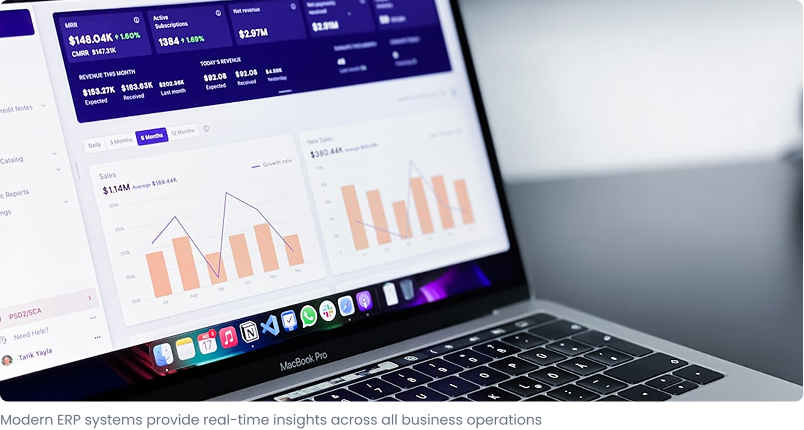Israr Ahmed
May 20, 2025 • 8 min read

Learn how an ERP Inventory Management System streamlines inventory tracking, automates reordering, and improves accuracy for modern businesses.
Whether you're selling online, in-store, or supplying other businesses, efficient inventory management is crucial for retailers. Without a reliable system in place, you risk stockouts, overstocking, inaccurate financials, and missed sales opportunities. An ERP Inventory Management module brings structure, automation, and visibility to your stock operations.
An ERP Inventory Management module is a core component of a broader ERP system. It consolidates all inventory-related processes like tracking, replenishment, reporting, and warehouse control into a single, integrated platform. Unlike basic inventory tools, it syncs with other business functions like procurement, sales, finance, and manufacturing.
Track inventory in real-time, providing accurate data about stock levels across different locations. This ensures businesses always know how much inventory they have, where it's located, and when it needs replenishing.
Benefits:
When stock levels reach predetermined reorder points, the ERP system automatically triggers new orders. This helps avoid stock-outs while reducing the risk of overordering.
Benefits:
Track and optimize inventory costs by calculating the cost of goods sold (COGS), stock carrying costs, and order fulfillment costs. This provides comprehensive understanding of unit costs.
Benefits:
Offers centralized control of inventory across all sites. Manage inventory levels at different warehouses, retail stores, or distribution centers with synchronized data.
Benefits:
Integrate with barcode scanners and RFID technology to automate inventory tracking and reduce errors. Track products as they move through the supply chain.
Benefits:
Integrates with the entire supply chain, from procurement to order fulfillment. Collects and analyzes data to optimize purchase orders and track suppliers.
Benefits:
Uses historical sales data and trends to predict future demand for products. Helps businesses plan and adjust inventory levels based on anticipated demand.
Benefits:
Provides detailed reports and analytics to track inventory performance, sales trends, and supplier effectiveness. Enables data-driven decision making.
Benefits:
Integrated warehouse management features including picking, packing, shipping, and inventory tracking, all within the ERP platform.
Benefits:
Streamlines the order-to-fulfillment process from order creation to shipment tracking. Ensures orders are processed quickly and efficiently.
Benefits:
Easily track returned items, manage restocking, and analyze return reasons. Provides valuable insights into product quality and inventory forecasting.
Benefits:
Closely integrated with procurement functions to track supplier orders, manage purchase orders, and maintain strong supplier relationships.
Benefits:
| Benefit | Description |
|---|---|
| Increased Efficiency | Automation of inventory tasks reduces manual errors and saves time across all operations. |
| Cost Savings | Real-time tracking and demand forecasting help avoid overstocking, minimizing carrying costs. |
| Better Decision Making | Centralized data from all departments gives businesses a clearer picture of inventory needs. |
| Improved Customer Satisfaction | Accurate inventory tracking means fewer stock-outs and faster order fulfillment. |
Before implementing an ERP, businesses often face numerous inventory management challenges that significantly impact operations and customer satisfaction:
This module benefits businesses across various industries that need efficient inventory management, especially those with complex stock requirements, multiple locations, and growing operational demands.
An efficient inventory system is critical to keeping your business agile, cost-effective, and responsive to customer demand. ERP inventory modules do more than just track products — they connect your inventory to every part of your operations, helping you make smarter decisions, reduce manual errors, and maintain control as your business scales.
Whether you manage a single warehouse or a multi-location retail chain, the right ERP solution should offer real-time visibility, seamless integration, and the flexibility to grow with you.
Selecting the right ERP inventory system starts with identifying your operational challenges. A reliable system should address these problems while supporting your growth with essential features like real-time stock updates, automated reordering, and multi-location inventory visibility.
Israr Ahmed
ERP Systems Specialist at SA Systems
Israr specializes in ERP implementations and inventory management optimization strategies for modern enterprises.
 ERP
ERPMarch 15, 2025
 ERP
ERPFebruary 28, 2025
.png) ERP
ERPJanuary 20, 2025
.png) Real Estate
Real EstateDecember 10, 2024